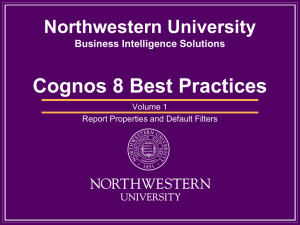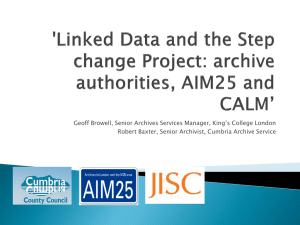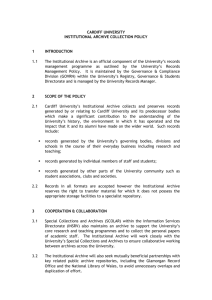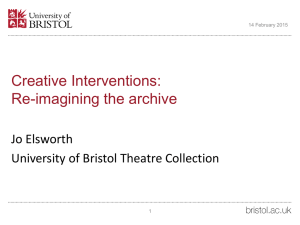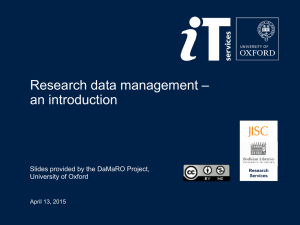Section 4: Hardware Architecture
advertisement
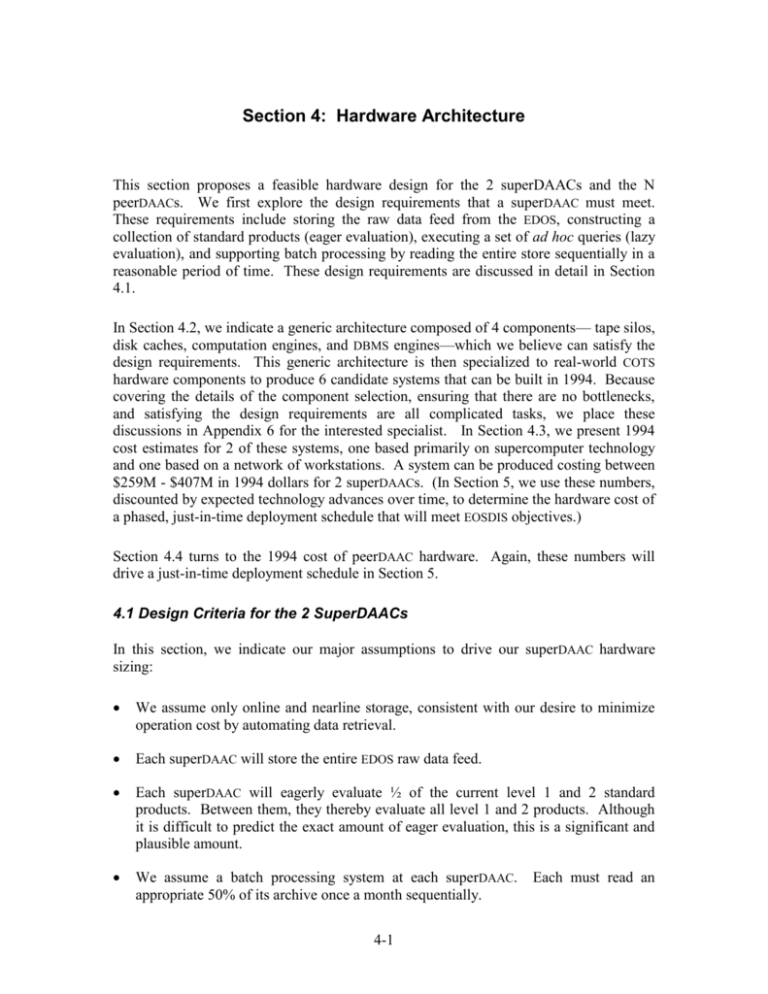
Section 4: Hardware Architecture This section proposes a feasible hardware design for the 2 superDAACs and the N peerDAACs. We first explore the design requirements that a superDAAC must meet. These requirements include storing the raw data feed from the EDOS, constructing a collection of standard products (eager evaluation), executing a set of ad hoc queries (lazy evaluation), and supporting batch processing by reading the entire store sequentially in a reasonable period of time. These design requirements are discussed in detail in Section 4.1. In Section 4.2, we indicate a generic architecture composed of 4 components— tape silos, disk caches, computation engines, and DBMS engines—which we believe can satisfy the design requirements. This generic architecture is then specialized to real-world COTS hardware components to produce 6 candidate systems that can be built in 1994. Because covering the details of the component selection, ensuring that there are no bottlenecks, and satisfying the design requirements are all complicated tasks, we place these discussions in Appendix 6 for the interested specialist. In Section 4.3, we present 1994 cost estimates for 2 of these systems, one based primarily on supercomputer technology and one based on a network of workstations. A system can be produced costing between $259M - $407M in 1994 dollars for 2 superDAACs. (In Section 5, we use these numbers, discounted by expected technology advances over time, to determine the hardware cost of a phased, just-in-time deployment schedule that will meet EOSDIS objectives.) Section 4.4 turns to the 1994 cost of peerDAAC hardware. Again, these numbers will drive a just-in-time deployment schedule in Section 5. 4.1 Design Criteria for the 2 SuperDAACs In this section, we indicate our major assumptions to drive our superDAAC hardware sizing: We assume only online and nearline storage, consistent with our desire to minimize operation cost by automating data retrieval. Each superDAAC will store the entire EDOS raw data feed. Each superDAAC will eagerly evaluate ½ of the current level 1 and 2 standard products. Between them, they thereby evaluate all level 1 and 2 products. Although it is difficult to predict the exact amount of eager evaluation, this is a significant and plausible amount. We assume a batch processing system at each superDAAC. appropriate 50% of its archive once a month sequentially. 4-1 Each must read an At each superDAAC, we assume that 4% of the data read in a batch processing run qualifies for some batched user query. Of this 4%, we assume that ½ of its resulting computations must be stored at the superDAAC. Some level 1 and 2 standard products will require reprocessing when their algorithm changes. We assume that reprocessing requests form part of the batch query queue. Therefore, we assume part of the 4% mentioned above is reprocessing requests. Specifically, we assume 2% of the total raw data may be turned into new standard products monthly. We assume that ½ of the new products are stored at a superDAAC and ½ at a peerDAAC. We assume that lazy evaluation of queries accesses, in aggregate, 0.9% of the entire database each week at each superDAAC. This value is chosen to provide a load comparable to the base push-processing load and can be adjusted up or down as conditions warrant. Of this 0.9%, 1/20 (5%) requires processing with 1/3 computed locally at the superDAAC and 2/3 at a peerDAAC. We assume that DBMS metadata and metadata indices are stored permanently in a disk cache. Metadata is assumed to be 0.1% of the size of the total database. Two copies of the metadata are stored at each site for redundancy. Metadata indices are assumed to be 10% of the size of the metadata. A database log of all database actions is maintained on tape. The size of the log is assumed to be a fixed fraction of the archive size. For this study, we assume that 4 bytes of log entry are created for every 64 KB that are stored. We assume that disk cache must provide storage for 1% of the data in the database or, conversely, storage for 1 week of standard product generation. We require the tape drives to sustain streaming of 50% of the archive past DBMS datasubsetting engines each month and picking of individual 100-MB data sets at the rate of 1 data set every 2 minutes per drive. The superDAAC is sized to perform the above functions for data received through the year 1999. After that, the system must be scaled by 2 PB per year in years 2000 through 2002. Table 4-1 summarizes this set of design criteria, using the current launch schedule and definition of level 1 and 2 standard products. 4-2 Table 4-1: SuperDAAC Sizing Assumptions Item Tape archive Disk cache Computation—eager Raw feed Level 1-2 products Computation—lazy Computation— reprocessing Characteristic Detail Comments Size 2 PB Size of raw feed plus level 1 and 2 products for 3 years, plus some spare capacity Sustained datastreaming rate Re-read 50% of archive each month Design requirement Access rate 366 MB/s Design requirement Sustained data picking rate 0.5 accesses per minute Design requirement Database log 0.006% of archive 4 bytes per 64K of data is .0006% Size—standard products 1% of archive size Design requirement Size—metadata and copy 0.1% of archive size Design requirement % eager processing 50% of raw data Each superDAAC does 50% of eager evaluation Peak rate 3.3 MB/s From HAIS design documents Size after 3 years 180 TB From HAIS design documents Peak rate 15 MB/s From HAIS design documents, with 50% eager evaluation Size after 3 years 1350 TB From HAIS design documents Eager computation rate 7.5 Gflops % lazy access 0.9% of archive per week Design requirement Peak access rate 30 MB/s Design requirement % lazy processing 5% of accessed data per week Design requirement Peak data subset rate 1.5 MB/s Design requirement Lazy computation rate 5 Gflops The superDAAC does 1/3 of the computation; the peerDAAC does the other 2/3 % of raw data processed 2% of total raw data each month Design requirement Peak data subset rate 30 MB/s Design requirement Peak computation feed rate 1.5 MB/s Design requirement Reprocessing computation rate 7.5 Gflops Design requirement The resulting design for the superDAAC is: 4-3 Each superDAAC does 50% of the computation listed in the HAIS design document 2 PB of archive data stored in tape robots. 20 TB of disk cache to support interactive retrieval of standard products. 4 TB of metadata disk storage (2 copies of the 2-TB metadata). 280 GB of real memory (RAM cache) to provide metadata hot index memory cache and data computation memory cache. 20 Gflops sustained execution rate. 100 MB/s local area network within the superDAAC. Two OC-3 links between the superDAACs. T3 or faster WAN links to a certain number of peerDAACs. 30-day time to read the entire data archive. 4.2 SuperDAAC Hardware Architecture The basic hardware components of the superDAACs are illustrated in Figure 4-1. They consist of a data multiplexing platform to support the raw feed, a database platform, a request queueing platform, and compute platforms. A high-speed network links the platforms. The superDAACs support 4 data flows: Raw feed storage and standard product generation. Each superDAAC calculates ½ of the standard products. Lazy evaluation of requests that access 0.9% of the archive each week. Stream processing of the archive each month. Each superDAAC reads ½ of the archive and is able to reprocess up to 2% of the total raw data each month. Imaging of the data archived at the other superDAAC so each superDAAC is a mirror of the other. 4-4 Feed from EOS and 2nd SuperDAAC Multiplexer DBMS Server Compute Server Interconnect Request Queueing System 2nd SuperDAAC PeerDAACs Public Figure 4-1: SuperDAAC Hardware Platforms Figure 4-2 shows the associated data flows for eager processing of the raw feed. The input data stream contains both the raw feed and the data that is being backed up from the other superDAAC. The compute platforms process only the raw feed data and store half of the results in the data archive. These data are backed up to the other superDAAC. 3.4 MB/s Feed from EOS and 15 MB/s 2nd SuperDAAC 3.4 MB/s Multiplexer 18.4 MB/s Compute Server 7.5 MB/s 7.5 MB/s Archive Figure 4-2: Eager Processing Data Flow Figure 4-3 shows the associated data flows for processing interactive queries to the database. Data is pulled from the archive in 100-MB chunks. The appropriate data subset is generated. The processing is then split between the superDAAC and the peerDAACs, with 1/3 of the processing being done at the superDAAC. PeerDAAC & Public PeerDAAC 2 MB/s Archive 30 MB/s 10 MB/s DBMS Server 1 MB/s Figure 4-3: Lazy Processing Data Flow 4-5 Compute Server Figure 4-4 shows the associated data flows for the data streaming system that supports queued requests. Half of the data archive is streamed through the data-subsetting platform at each superDAAC. A data subset is generated that is equal in size to 2% of the accumulated raw feed. This, in turn, is processed to create new products. Half of the resulting data is stored back in the archive. 7.5 MB/s Archive 366 MB/s DBMS Server 1.5 MB/s Compute Server Figure 4-4: Streaming Data Flow A detailed design of superDAAC hardware that specialized this architecture to 6 collections of 1994 COTS hardware components is discussed in Appendix 6. 4.3 SuperDAAC Cost Analysis In this section, we present 2 example configurations that are discussed in detail in Appendix 6 and meet the design requirements of Section 4.1. Table 4-2 describes the superDAAC configurations. Table 4-2: SuperDAAC Configurations Type of platform Storage device Database platform Compute server Interconnect technology Request queueing system WS/NTP IBM NTP 3495 DEC 7000 DEC 7000 ATM CS 6400 Vector/NTP IBM NTP 3495 CS 6400 Supercomputer HIPPI CS 6400 Both use an IBM tape silo, an NTP 3495, and a CRAY Superserver made up of SPARC processors (CS-6400) as the request queuing system. In the workstation-oriented system (WS), a DEC Alpha machine (DEC 7000) forms the basis for the compute server and the database platform. A large collection of interconnected machines is required to satisfy the load, and an ATM switch is used to provide connectivity. The second configuration is more conservative and uses a CRAY C90 as a compute server (instead of a network of workstations) and a CRAY CS-6400 as a DBMS engine. Table 4-3 indicates the 1994 hardware cost of each configuration. 4-6 Table 4-3: SuperDAAC Hardware Components Type of platform Max number of days to read archive Number of data servers Number of compute servers Number Data Disk of tape server cache robots cost ($M) cost ($M) Archive Compute tape cost platform ($M) cost ($M) Total hardware cost ($M) WS/NTP 27.7 18 106 8 $29.5 $31.5 $12.8 $55.7 $129.5 Vector/NTP 27.7 2 4 8 $31.0 $31.5 $12.8 $128.0 $203.3 The table indicates the number of each component needed, the aggregate cost of each component, and the total hardware cost. Notice that the conservative design is $203M, while the network of workstations saves dramatically on the compute server and costs $129.5M. In our opinion, these 2 designs bracket the reasonable costs of a real system and can be used safely for the cost analysis in Section 5. 4.4 PeerDAAC Cost Analysis A modified version of the design criteria used for the superDAACs can be applied to the design of peerDAACs. The same hardware systems are used: data storage devices, database server platforms, network switches, and compute servers. However, we assume 2 different load requirements for peerDAACs: A minimal peerDAAC that can archive 0.5% of the raw data and do associated lazy evaluation of queries. This would be a peerDAAC for a single research group or small collection of groups. A larger peerDAAC that can archive 2% of the raw data and do associated lazy processing. This would be a peerDAAC for a substantial collection of users. In Table 4-4, we indicate the sizing of 2 minimal peerDAAC configurations, one based on the IBM RS/6000 and the DEC TL820 tape silo, and the second based on a DEC Alpha and DEC DLT tape stacker. Note the total price of a minimal peerDAAC varies between $2.04M and $3.52M. 4-7 Table 4-4: Minimal PeerDAAC 4-8 Type of platform Max Num-ber Num-ber Number of Data number of of data of comtape servers days to server pute robots cost read servers archive Disk Archive cache tape cost cost Compute platform cost Hardware cost IBM RS/6000/ TL820 12.5 2 1 2 $1.35 $0.11 $0.22 $0.37 $2.04 DEC 7000/DLT 0.7 3 1 56 $2.01 $0.11 $0.85 $0.55 $3.52 In Table 4-5, we scale the 2 options upward to satisfy the requirements of a large peerDAAC. The cost climbs to $2.86M to $4.22M. These numbers will be used in Section 5 for downstream peerDAAC cost estimates. The details of peerDAAC configuration appear in Appendix 6. Table 4-5: Large PeerDAAC Costs Type of platform Max Number of Number of Num-ber number data compute of tape of days to server servers robots read servers archive Data servers cost Disk cache cost Archive Compute tape cost platform cost Total hardware cost IBM RS/6000/ TL820 12.5 2 2 6 $1.03 $0.43 $0.66 $0.74 $2.86 DEC 7000/NTP 3.0 2 2 1 $1.38 $0.43 $1.31 $1.10 $4.22 4-9

